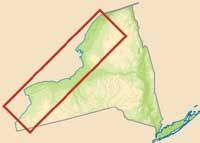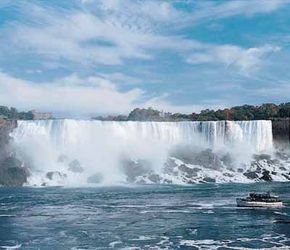New York's Seaway Trail brings the nation's earliest days to life and makes the nation's present days more lively. Follow this 454-mile byway paralleling the St. Lawrence River, Lake Ontario, Niagara River, and Lake Erie and discover historical scenery that is anything but sleepy.
Delight in this drive through naturally scenic landscapes, welcoming harbors, city skylines, and quaint villages. Plan time to pause at fresh fruit and vegetable stands or sample apple pie and the sweetest corn in the country at farmers' markets, country fairs, and u-pick farms.
Advertisement
You'll find festivals from Chautauqua's vineyards to Niagara Falls celebrating every season. Beyond the flavor of the rural community, travelers will find high culture in the cities along the byway as well. Cities such as Rochester and Buffalo offer a myriad of museums and a slew of historic sites.
With some of the world's best year-round sportfishing, anglers looking to catch the big one just may find it along the Seaway Trail. The shores of Lake Ontario and Lake Erie present plenty of options for water recreation. Historic lighthouses also line the trail, creating stops for further exploration. And if you enjoy a picnic in the park, there are many sites to choose from at the state parks lining the byway.
Cultural Qualities of Seaway Trail:
The state of New York has been developing its culture for hundreds of years. Cities and towns along the Great Lakes and the St. Lawrence River add flavor not only to the Seaway Trail, but to the nation as well. As you travel this National Scenic Byway, spend a night in a cozy bed-and-breakfast, or tour a historical site from the War of 1812.Whatever you do, you will become acquainted with the culture of the Seaway Trail. It is a culture immersed in history and at the cutting edge of change.
The cultures of the Iroquois and the Mohawk leave an intriguing legacy that reflects an America of the past. These cultures can be rediscovered on the Seaway Trail in places like the Seneca Iroquois National Museum in Salamanca or the Akwesasne Cultural Center in Hogansburg. Businesses all along the trail display the crafting of the past in beautiful beadwork, cornhusk dolls, and silversmithing. The presence of these cultures is also apparent in their seasonal festivals and powwows.
Eventually, these cultures mixed in with the British and the French as they arrived to stake their claim in the New World. The roots of these lasting European influences are commemorated at Old Fort Niagara as well as many other historic sites. As the country opened up to other European cultures, Italian and Greek immigrants made their way to New York as well. Their mark can be seen in the Old World architecture and woodcarvings in towns along the way. The cultures of a few religions also have roots on the Seaway Trail. Travelers on the trail will be able to visit Amish farms, remnants of Shaker heritage, or historic sites significant to the Mormon Church. These cultures have been mixing over the years to form the diversity of festivals and monuments along the trail today.
One of the best places to experience the culture of the Seaway Trail is in the local restaurants and bed-and-breakfasts. Here, you will discover an old-fashioned hospitality that has been preserved and handed down from eras that came before. In the towns and the cities on the trail, historic buildings have been converted to places to rest and enjoy the local cuisine. The people of the Seaway Trail are just waiting to share their heritage in their architecture and their recipes.
Ultimately, the Seaway Trail is a byway where visitors enjoy the diversity that the country has to offer. From festivals to fine dining, the Seaway Trail is sure to have a cultural style that intrigues you.
:
Sea captains and military captains have created legacies along the Seaway Trail. Their stories are told, sometimes recreated, and sometimes only imagined all along the byway in the 42 different historic sites. Learn about the history of the war that inspired the "Star-Spangled Banner." Many sites from the War of 1812 are located all along the byway and marked for visitor convenience. Quiet towns along the way offer a portal into the past where sea captains built their homes and simple businesspeople lived and worked. Visit America's oldest freshwater port in Oswego, and see if you can spot all 28 lighthouses located along the way. The ghosts of a maritime culture still haunt this byway. The Seaway Trail is full of history and dozens of ways to explore it.
Old forts and battle structures still remain all along the byway, one of which is Old Fort Niagara. This fort is located close to the famous falls of the same name and boasts 300 years of history of being passed from the French to the British and finally, to the Americans. As a gateway to the Great Lakes, the St. Lawrence River, and thus, the interior of the country, the Fort was situated in an extremely strategic position. As a result, it has a colorful history of battles and wars. Travelers will encounter a different world as they step through the gates of the fort. Soldiers and townspeople "from" 300 years ago are roaming about the area, ready to explain a black-powder rifle or the history of a battle. Historians who choose to live history come here to explain the past to visitors of the present.
Other structures along the byway leave more a sensation of mystery than of history. Visit Boldt Castle of the Thousand Island Region for a glimpse of true love and tragedy at the turn of the 20th century. The magnificent stone structures located in this area will transport travelers to another time and country through the architecture that is found only in the castles of Europe. All along the shores of the Great Lakes, lighthouses spring up to lure visitors to get out their cameras to capture their picturesque quality. Among the most significant of the Seaway's lighthouses are Dunkirk Lighthouse, Thirty Mile Point Lighthouse, and Sodus Point Lighthouse. These lighthouses, as well as many of the others, date back to the early 1800s when navigation in bad weather was dependent upon these beacons. Exploring the sites along the byway will only lead to a discovery of more of the abundant history that is embedded along the Seaway Trail.
:
Bays along the byway's edge sprout cattails, and the rivers and lakes create coves and overhangs of rock from another time. The bluffs that are familiar on the Seaway Trail often hold swallows' nests in the pockmarks in the rock. Because of natural sites that can be seen from the river, canoe trips are perhaps one of the best ways to see the natural world that thrives on the Seaway Trail every day. But whether you paddle or hike, the Seaway Trail offers a look at coexisting wildlife and geology.
Recognized for its bird-watching opportunities on some of America's most well known lakes and rivers, the Seaway Trail offers a natural view of New England. Bird species from waders to warblers flock to the Seaway Trail to enjoy the moderate climate with plenty of freshwater sources. Usually a hiking trail on the byway will take you into the thick of bird country where they can be seen with and without binoculars. From spring to winter, bird-watching remains an activity that can be enjoyed on the byway year-round. In the winter, visitors may catch a glimpse of a snowy owl, and in the spring, birds of prey visit the byway on the Lake Erie shoreline. All along the St. Lawrence River, beavers, ducks, and porcupine continue to make a home as they have for thousands of years.
It would seem that the land itself is alive on the byway. Lakes are lapping, rivers are rushing, and stone is being sculpted ever so slowly. Some of the most prominent geological features on the byway are the Chimney Bluffs. These peaks and spires amid a mixture of clay are found inside a drumlin on Lake Ontario. Traveling down the St. Lawrence River, you'll notice rocks of a pink hue beneath the water's surface and on the shore. This rock is some of the oldest in North America with the same composition as the Adirondacks. A landmark of international fame rests between Lake Ontario and Lake Erie on the Seaway Trail. Every year, visitors come from miles around to witness the power and splendor that belong to Niagara Falls. Water plunges from the upper Niagara River to the channel below to create an effect that has mesmerized humanity for centuries.
:
With state parks and bustling cities all along the route, the Seaway Trail is not lacking in the selection of activities it offers visitors. Throughout the year, visitors to the byway enjoy shorelines and waterways with plenty of access. In the winter, when water sports might be less appealing, there is always the draw of both downhill and cross-country skiing. There are more than 30 state parks just along the byway. Detour off the road a bit and you'll find a few more. Little villages and points of interest lure visitors all along the trail. The natural beauty of the Finger Lakes is almost as enticing as the legend behind them. Lighthouse enthusiasts will want to tour all 28 of the historic lighthouses from Lake Erie to the St. Lawrence Seaway. Exciting adventures await among the Thousand Islands Area. A flavor for life by the sea is what visitors will acquire after spending time on this byway.
Get to know the Seaway Trail before you go and learn the locations of its many eye-opening treasures, hopping cities, quaint villages, laid back fishing ports, exciting family attractions, and more in the next section.
Find more useful information related to New York's Seaway Trail:
- New York Scenic Drives: Seaway Trail is just one of the scenic byways in New York. Check out the others.
- How to Drive Economically: Fuel economy is a major concern when you're on a driving trip. Learn how to get better gas mileage.
Advertisement

